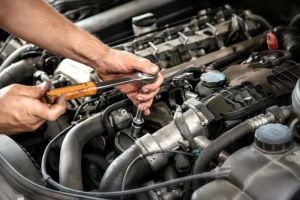Exhaust Leak Detection: How to Spot and Fix a Problem Before It Gets Worse
As a driver, one of the last things you want to deal with is an exhaust leak. However, this is a common issue that many car owners encounter at some point. Over the years, I’ve come across countless vehicles in distress due to exhaust leaks, and while they might seem like a minor inconvenience, they can actually lead to more significant and expensive problems if left unchecked. An exhaust leak can affect your car’s performance, fuel efficiency, and, in some cases, even your health. I’m here to walk you through how to detect an exhaust leak, why it’s important to address it promptly, and how to handle the situation efficiently.
1. What Is an Exhaust Leak?
At its core, an exhaust leak is any break or crack in your vehicle’s exhaust system. The exhaust system is responsible for directing harmful gases away from the engine and out of the car’s tailpipe. It’s designed to handle high-pressure gases and extreme temperatures, but over time, the components of the system can wear down or become damaged, leading to leaks.
The most common culprits for exhaust leaks are the exhaust manifold, gaskets, pipe connections, and the catalytic converter. The leak may not always be visible, but it’s important to understand the risks of driving with a leaking exhaust system. In my years working in roadside assistance and car repairs, I've seen how quickly an exhaust leak can turn into a much bigger issue if left unaddressed.
2. Common Symptoms of an Exhaust Leak
Understanding the symptoms of an exhaust leak is the first step in detecting the issue before it worsens. From my personal experience, these are the most common signs that indicate a potential exhaust leak:
- Increased Noise: One of the easiest signs to notice is an increase in noise. A loud, rumbling, or hissing sound coming from underneath the car, particularly when accelerating, is a clear indication that there is a leak somewhere in the exhaust system. The sound typically becomes more pronounced as you accelerate.
- Decreased Fuel Efficiency: If your car suddenly starts using more fuel than usual, it could be due to an exhaust leak. The leak can disrupt the engine’s ability to expel exhaust gases efficiently, causing the engine to work harder, which results in poor fuel economy.
- Strange Smell or Carbon Monoxide: Exhaust leaks can sometimes allow harmful fumes, including carbon monoxide, to enter the cabin of the car. I’ve had several customers report a strange odor or even headaches due to this. It’s important to check for leaks immediately, as carbon monoxide is a dangerous, colorless gas that can be harmful to your health.
- Illuminated Check Engine Light: In some cases, a leaking exhaust system triggers the check engine light. This could be due to a malfunctioning oxygen sensor or an issue with the engine’s fuel efficiency. If your check engine light is on and you notice other symptoms, it’s time to investigate further.
3. How to Detect an Exhaust Leak
Once you’re aware of the symptoms, the next step is to detect the leak itself. In my experience, finding an exhaust leak isn’t always straightforward, but there are several methods you can use to track it down.

Caldwell Custom Exhaust
67 Robinson St, Waynesville, NC 28786, USA
3.1 Visual Inspection
The first step in locating an exhaust leak is a visual inspection. Begin by inspecting the exhaust pipes, gaskets, and connections. Look for signs of rust, holes, cracks, or damage. If the car has been exposed to salt or moisture, corrosion can easily occur, especially in the exhaust manifold or pipes. If you notice any visible damage, it’s likely that’s where the leak is.

MECHANIC ON THE SPOT 24/7
1869 W Vernon Ave, Los Angeles, CA 90062, USA
3.2 Listen for Leaks
When I suspect an exhaust leak, one of the easiest methods I use is to listen carefully. Have the engine running, and use your ears to track down the source of the sound. The sound of a hissing or a popping noise is usually a good indication of a leak in the system. If you’re not sure, you can also ask someone to rev the engine while you listen from underneath the car. Just be sure to exercise caution when working around a running engine.
3.3 Use Soapy Water
If you’re not able to visually detect the leak or hear it, you can try using soapy water. Simply mix some dish soap with water in a spray bottle, and spray it over areas where you suspect a leak, such as the exhaust manifold, connections, and pipes. If there’s a leak, you’ll see bubbles form where the air is escaping. This method is quick and effective for pinpointing small leaks.
3.4 Exhaust Leak Detection Kit
For a more thorough inspection, there are specialized exhaust leak detection kits available. These kits typically contain a chemical that reacts with exhaust gases and changes color when exposed to them. Using this method can help confirm the presence of a leak and identify its exact location.
4. Repairing an Exhaust Leak
Once you’ve located the exhaust leak, the next step is to repair it. Whether you choose to handle the repair yourself or call in a professional, here are a few tips I’ve gathered over the years:
4.1 Temporary Solutions
While it’s always best to replace the damaged part, if you’re stuck on the road and need a temporary solution, there are a few quick fixes. One option is using a high-temperature exhaust tape. I’ve used this in emergency situations to temporarily seal off a small hole or crack, just long enough to get the vehicle to a repair shop. Keep in mind, though, that this is not a permanent fix.
4.2 Permanent Repair Options
The best way to repair an exhaust leak is by replacing the damaged part. If the leak is in a pipe, it might be necessary to replace the entire section. If the problem is with the exhaust manifold or gasket, those parts need to be replaced as well. Replacing the faulty parts ensures a long-lasting solution and restores the efficiency of your vehicle’s exhaust system. Depending on your skills and tools, you might be able to perform this repair yourself, but I usually recommend professional help for more complex jobs.
4.3 Professional Assistance
If you’re not comfortable repairing the exhaust leak on your own, or if the damage is more extensive, it’s a good idea to call a professional. A qualified mechanic can quickly diagnose and repair the issue, preventing further damage to your car. In some cases, a professional may recommend replacing the entire exhaust system, especially if the leak is widespread or caused by significant corrosion.
5. Preventing Exhaust Leaks
While exhaust leaks can happen at any time, there are several steps you can take to prevent them. I’ve found that regular maintenance and inspection can go a long way in extending the life of your exhaust system and keeping you safe on the road:
- Regular Inspections: Just like any other part of your vehicle, the exhaust system needs regular attention. I recommend having it inspected during routine oil changes or every 12,000 miles to catch any potential issues before they become serious.
- Keep the Exhaust System Clean: Salt, dirt, and moisture can accelerate corrosion in your exhaust system. I always make sure to wash the undercarriage of my vehicle, especially during winter months when road salt is prevalent.
- Avoid Overloading Your Car: Excess weight on your vehicle can put additional stress on the exhaust system, increasing the risk of damage. Always follow the manufacturer's recommended weight limits to prevent unnecessary strain.
6. When to Call for Professional Help
If you suspect an exhaust leak but aren’t able to locate or fix it on your own, it’s always a good idea to call a professional. Sometimes the leak might be hidden in a hard-to-reach area, or the damage may be more extensive than you initially thought. In these cases, calling a professional can save you time, effort, and money in the long run. Services like Rescue & Towing can help by towing your vehicle to a trusted repair shop if necessary and provide expert advice on repairing the leak.
Exhaust issues can be tricky, but with the right tools, knowledge, and help from professionals, you can get your vehicle back in top shape and ensure it continues to run smoothly for years to come.




























